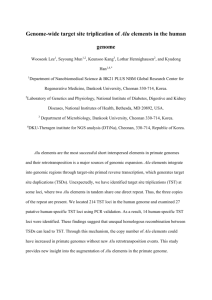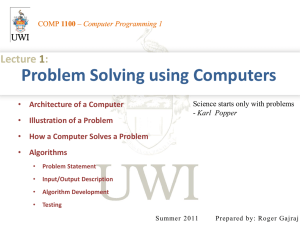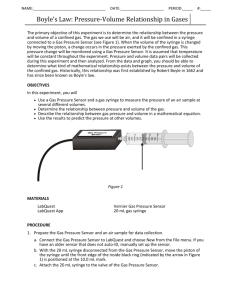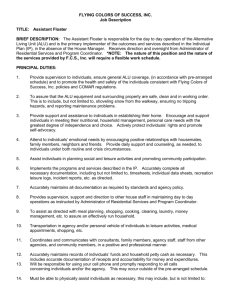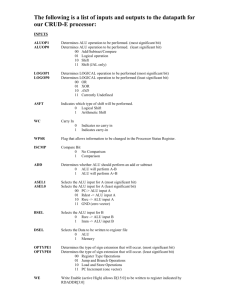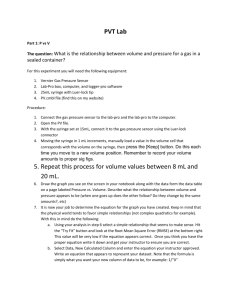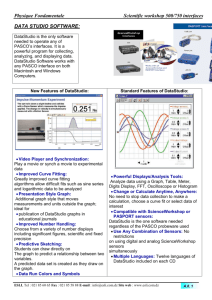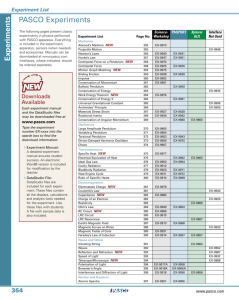Activity C07: Boyle`s Law: Pressure – Volume Relationship in Gases
advertisement
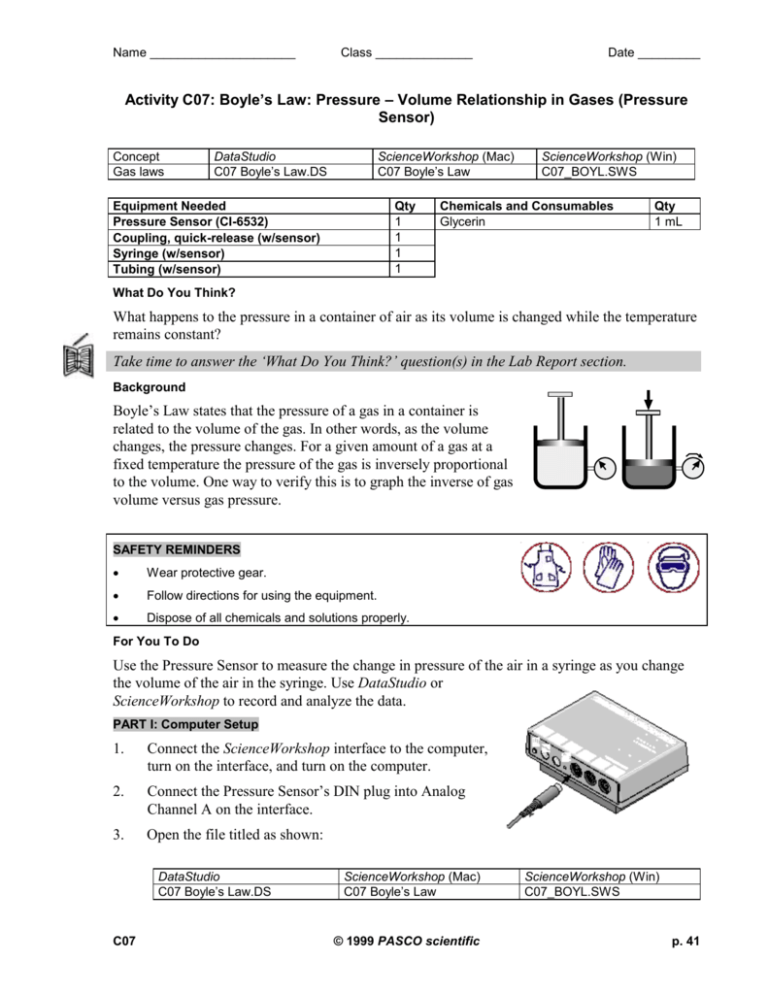
Name _____________________ Class ______________ Date _________ Activity C07: Boyle’s Law: Pressure – Volume Relationship in Gases (Pressure Sensor) Concept Gas laws DataStudio C07 Boyle’s Law.DS ScienceWorkshop (Mac) C07 Boyle’s Law Equipment Needed Pressure Sensor (CI-6532) Coupling, quick-release (w/sensor) Syringe (w/sensor) Tubing (w/sensor) Qty 1 1 1 1 ScienceWorkshop (Win) C07_BOYL.SWS Chemicals and Consumables Glycerin Qty 1 mL What Do You Think? What happens to the pressure in a container of air as its volume is changed while the temperature remains constant? Take time to answer the ‘What Do You Think?’ question(s) in the Lab Report section. Background Boyle’s Law states that the pressure of a gas in a container is related to the volume of the gas. In other words, as the volume changes, the pressure changes. For a given amount of a gas at a fixed temperature the pressure of the gas is inversely proportional to the volume. One way to verify this is to graph the inverse of gas volume versus gas pressure. SAFETY REMINDERS Wear protective gear. Follow directions for using the equipment. Dispose of all chemicals and solutions properly. For You To Do Use the Pressure Sensor to measure the change in pressure of the air in a syringe as you change the volume of the air in the syringe. Use DataStudio or ScienceWorkshop to record and analyze the data. PART I: Computer Setup 1. Connect the ScienceWorkshop interface to the computer, turn on the interface, and turn on the computer. 2. Connect the Pressure Sensor’s DIN plug into Analog Channel A on the interface. 3. Open the file titled as shown: DataStudio C07 Boyle’s Law.DS C07 ScienceWorkshop (Mac) C07 Boyle’s Law © 1999 PASCO scientific ScienceWorkshop (Win) C07_BOYL.SWS p. 41 Chemistry Labs with Computers C07: Boyle’s Law (P & V) Student Workbook 012-07005A • The ScienceWorkshop document has a Digits display of Pressure, a Graph display of Volume and Inverse Volume versus Pressure, and a Table of Pressure, Volume and Inverse Volume. • The DataStudio file has a Workbook display. Read the instructions in the Workbook. • Data recording is set for one measurement per second. Use the keyboard to enter the volume of the air inside the syringe (in milliliters). PART II: Sensor Calibration and Equipment Setup You do not need to calibrate the sensor. 1. Put a drop of glycerin on the barb end of a quick release coupling. Put the end of the coupling into one end of a short piece (about 2.5 cm) of plastic tubing that comes with the Pressure Sensor. 2. Put a drop of glycerin on the end of the syringe. Connect the end of the syringe to the other end of the small piece of plastic tubing. 3. Align the quick-release coupling on one end of the plastic tubing with the pressure port of the Pressure Sensor. Push the coupling onto the port, and then turn the coupling clockwise until it clicks (about one-eighth turn). 4. Check that the syringe and Pressure Sensor have a secure seal by adjusting the volume between 20 mL and 10 mL. It should get harder to push as the volume decreases. 5. Adjust the volume of air in the syringe to 20.0 mL. (Note: To set the initial position of the piston in the syringe, disconnect the quick-release connector from the sensor, move the piston to the first position (20 mL), and then re-connect the quick-release connector to the sensor.) p. 42 © 1999 PASCO scientific C07 Name _____________________ Class ______________ Date _________ PART III: Data Recording (for DataStudio) • In DataStudio, the Table display shows values for the gas volume in the syringe (for example, 20, 18, 16 and so on). 1. When everything is ready, start recording data. (Hint: In DataStudio, click ‘Start’). • In DataStudio, the ‘Start’ button changes to ‘Keep’ ( shows the value of pressure next to the first volume (20 mL). 2. Click ‘Keep’ to record the pressure. • The Table display changes to show the next value of volume (18 mL). 3. Move the piston to the 18 mL mark and click ‘Keep’ to record the pressure. 4. Continue to move the piston to each new position and then click ‘Keep’ to record the corresponding pressure. 5. After you record the pressure for the last volume, click ‘Stop’ ( C07 © 1999 PASCO scientific ) and the Table display ) to end data recording. p. 43 Chemistry Labs with Computers C07: Boyle’s Law (P & V) 6. p. 44 Student Workbook 012-07005A If time permits, repeat the procedure. © 1999 PASCO scientific C07 Name _____________________ Class ______________ Date _________ PART III: Data Recording (for ScienceWorkshop) 1. In ScienceWorkshop, click ‘REC’ to start recording data. • The Keyboard Sampling window opens. 2. When the pressure reading stabilizes, type “20” for the volume of air in the syringe and click ‘Enter’ to record the pressure. 3. Reduce the volume to 18 mL. Type 18 for the volume and click ‘Enter’. (Note: ScienceWorkshop will prompt you for the third volume based on the pattern of the first two volumes.) 4. Continue reducing the volume by 2.0 mL each time, checking the pressure, and entering the new volume until your last entered volume is 10.0 mL. 5. After you enter the last volume, click ‘Stop Sampling’ to end data recording. 6. If time permits, repeat the procedure. Analyzing the Data 1. Set up the Graph display so you can examine the plot of Volume versus Pressure and also the plot of Inverse Volume versus Pressure. 2. Set up the Table display so you can examine the Pressure, Volume and Inverse Volume. Use your observations to help you answer the questions in the Lab Report section. C07 © 1999 PASCO scientific p. 45 Chemistry Labs with Computers C07: Boyle’s Law (P & V) Student Workbook 012-07005A Lab Report - Activity C07: Boyle’s Law: Pressure – Volume Relationship in Gases What Do You Think? What happens to the pressure in a container of air as its volume is changed while the temperature remains constant? Questions 1. From looking at your data, do the pressure and volume seem to be directly or inversely proportional? Does this agree with Boyle’s Law? 2. What happened to the pressure when the volume went from 20 mL to 10 mL? 3. What are possible sources of error or limitations in this experiment? For each one, try to decide what effect it might have on the experimental results. p. 46 © 1999 PASCO scientific C07 Name _____________________ C07 Class ______________ © 1999 PASCO scientific Date _________ p. 47


